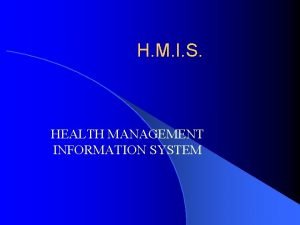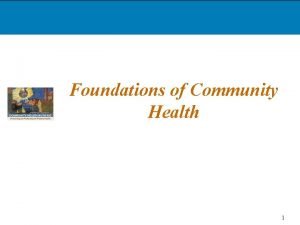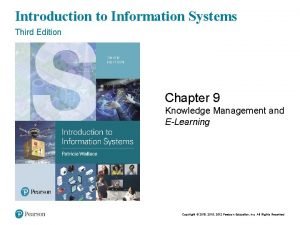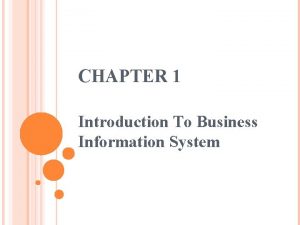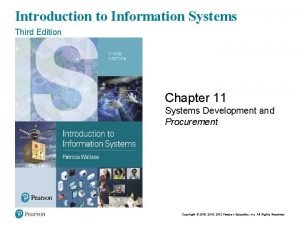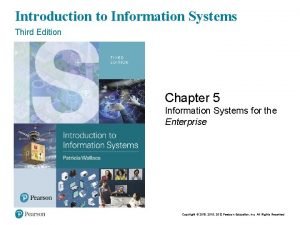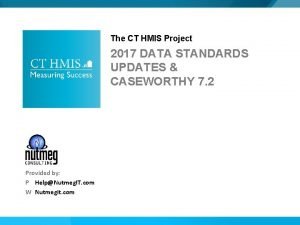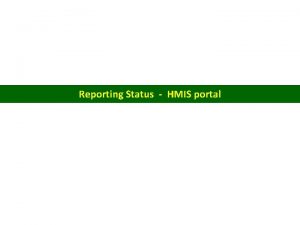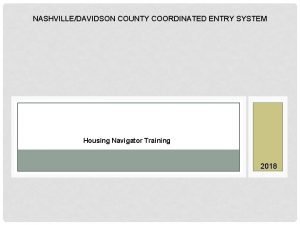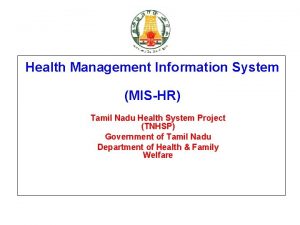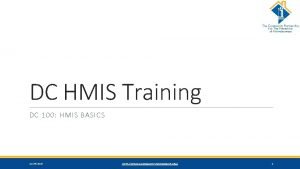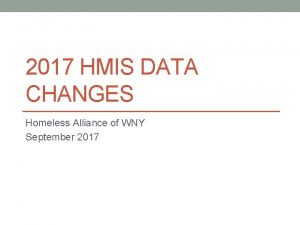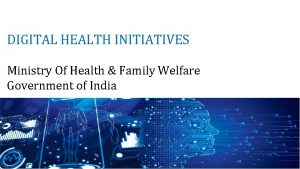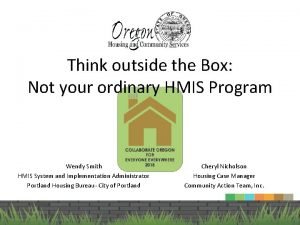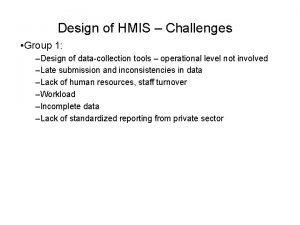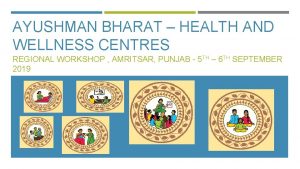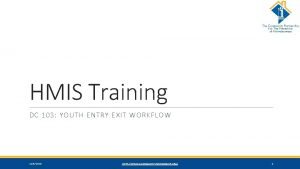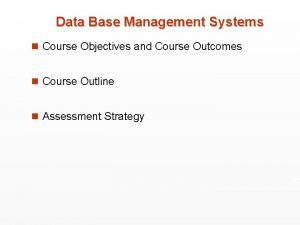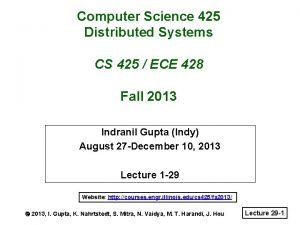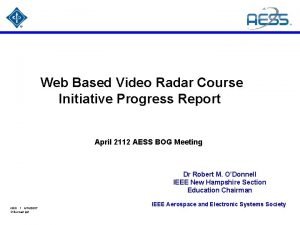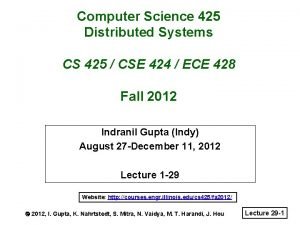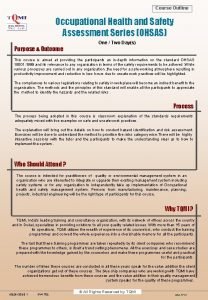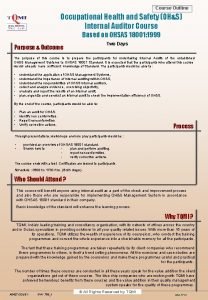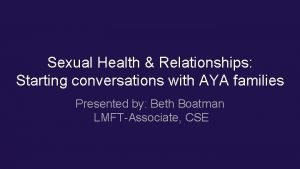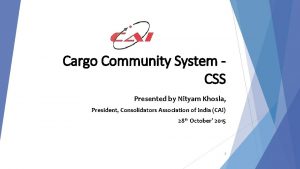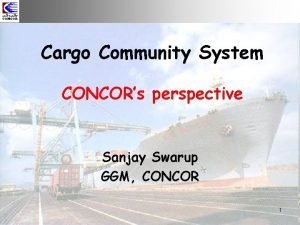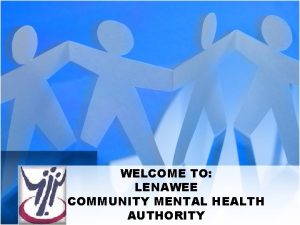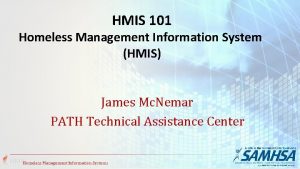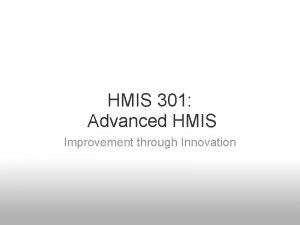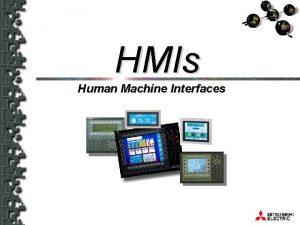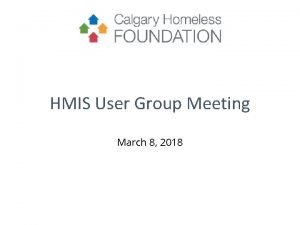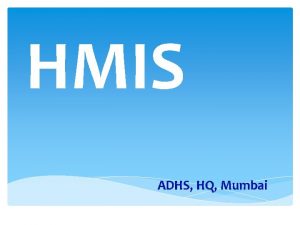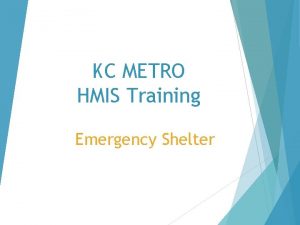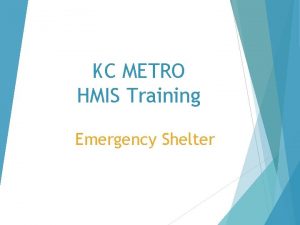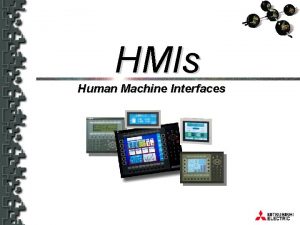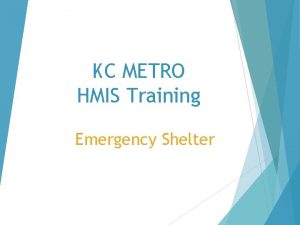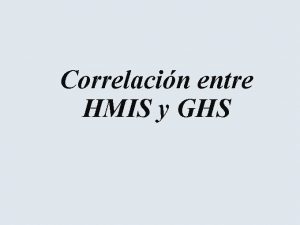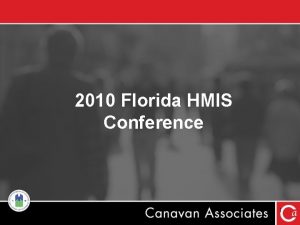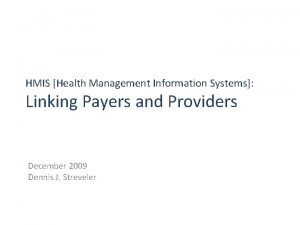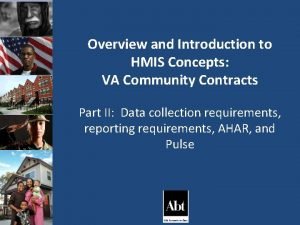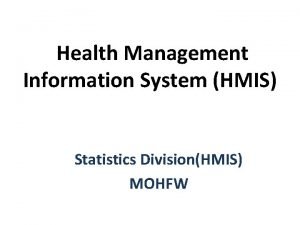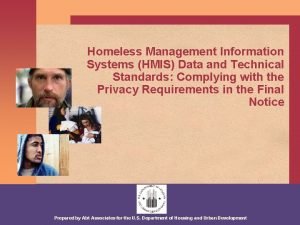Introduction Community Health Information Systems HMIS Course Scott


















































- Slides: 50

Introduction – Community Health Information Systems HMIS Course Scott Russpatrick

Overview 1. CHIS Principles 2. Zambia Use-case 3. CHIS Country Assessment Results 2

Why is this necessary? • Community is the new facility! • Child deaths alone could be cut by 63% worldwide if effective prevention and clinical services could be provided directly at community level increasing coverage from current levels to 99% • • m. Health tools need to be integrated into a single platform Community data needs to be integrated into the HMIS Community stakeholders need data to promote health programs 27 countries are already planning to take DHIS 2 to national scale as a CHIS 3

Foundational Term - Community • A community can be considered: – A social unit, such as a group of people, who have something in common, such as norms, values, or identity – A community includes a set of stakeholders who meet one or more of the following conditions: • Reside in a defined geographic area. • Share demographic traits (e. g. children under five, pregnant women). • Behavioural or occupational characteristics (e. g. sex workers, truck drivers). • Situational factors (e. g. orphans, prisoners). 4

What is going on in this community ? Where There is No Doctor, David Warner 5

Foundational Term – Community Health Worker • Community health workers should be: – members of the communities where they work, – should be selected by the communities, – should be answerable to the communities for their activities, – should be supported by the health system but not necessarily a part of its organization, – Should have a shorter training than professional workers. 6

Foundational Term – Community Health Worker • Community health workers are busy: – Providing care and appropriate referrals for patients/ beneficiaries. – Engaging with communities and their leaders. – Providing information, education and communication (IEC) activities. – Promoting public health in other locally specific actions. – Recording and reporting data to higher levels on activities performed and diseases identified for surveillance. – Managing stocks and inventory. – Providing training and supervising community-based activities. – Managing incentives to strengthen enrollment of beneficiaries in health programmes. 7

Foundational Term - CHIS • “A CHIS is a combination of paper, software, hardware, people and process which seeks to support informed decision making and action taking of CHWs. This includes: – Recording of basic data such as population, health program transactions, case based data, stock and resource availability – Tracking and taking action on individual program based needs such as disease surveillance, mortality and morbidity – Reporting and feedback including routine upward reports, feedback reports, ad hoc reports and specific reports for different stakeholders” 8

What is the reality? Lots of Data Up… Little feedback and Little action CHIS ICCM Nutrition WASH HIV/AIDS Malaria COMMUNITY 9

What is the reality? Too man parallel reporting systems. . 25% of m. Health and CBIS projects have >1000 users 10

Choking on m. Health • In countries there are dozens of parallel m. Health projects with little corrdination • Ministries report having little oversight or control over community reporting systems • Ministries want community data to feed into the HMIS • Interoperability is often custom and, so far, too expensive for ministries to maintain

Pilotitis “Frustration of many of those in the health sector at the continuing emphasis on demonstrating successful outcomes from narrowly focused interventions targeting relatively small populations. ” – Haung et al, 2017 Uganda • • • Session 1. 1 Introduction 80+ m. Health pilots in Uganda in 2008 All siloed, parallel, and unregulated m. Health moratorium in 2012 World Bank • • 2011 – 500 m. Health pitlot studies in progress Nothing knowns about uptake, efficacy, or effectiveness 12

What is the reality? Information Overload. . Zambia – 2015 300 community health data elements 13

How is A CHIS different than a HMIS? MALARIA TB HIV STOCKS Scope: CHIS IS HUGE ANC SUBSTANCE ABUSE CHILD HEALTH IGA NEONATAL COMMUNITY LEADERS WASH EDUCATION SHELTER, FEED AND RIASE THEIR OWN CHILDREN OUTBREAK CONTROL AGRICULTURE 14

CHIS as a bridge between HMIS and m. Health projects HMIS needs to scale to whole nations «all on nothing» logic of public health comprehensive approach m. Health is selective and targeted, often small scale and experimental • CHIS is an attempt to integrated community level initiatives (often m. Health projects) and align them with large scale HMIS Number of end users increase dramatically – A HMIS in a country of 10, 000 people my have • 350 health facilities (end users) – A CHIS in the same country: • 10, 000 CHWs 15

CHIS Design Session 1. 1 Introduction 16

17

Design Principles for CHIS 1. Design the CHIS to strengthen government ownership and sustainability. 2. Enable and strengthen community engagement. 3. Build a balance between reporting burden and provision of care. 4. Strengthening capacity of CHWs and other stakeholders as a team. 5. Follow incremental and evolutionary principles of system design and development. 18

1 9 CHIS Guidelines • Comprehensive guidelines on how to assess, develop, implement, and sustain a CHIS using DHIS 2 • Dozens of use-cases • A living document. • Colaboration of 14 Mo. H, 11 NGOs, Ui. O, UNICEF, HDC, and GF. • Available in English and French @ dhis 2. org/academy Session 1. 1 Introduction

Use-case 1: Community Lead Total Sanitation in Zambia Driving sanitation uptake via community change agents

Why Hygiene and Sanitation? ü 8. 3% of rural HHs observed with functional hand washing station (baseline survey) ü Access to improved sanitation: stagnation between 1990 and 2012 (JMP) ü Poor sanitation costs Zambia 1. 3% of the national GDP (WSP, 2012) ü 46% of Zambia Children are stunted ü Diarrheal diseases and regular outbreaks of Cholera and Typhoid

Community Led Total Sanitation (CLTS) • https: //vimeo. com/130126169

Community Led Total Sanitation (CLTS) • Empowers local communities to stop open defecation and to build and use latrines without the support of any external hardware subsidy – “Hardware” = bricks, cement, etc. – tangible – “Software” = sensitization, behavior change – intangible • Mobilizes communities to completely eliminate open defecation (OD)

The Zambia Journey Old System: Paper-to-Excel Community facilitators collect and aggregate handwritten records from each village…. SAG SAG SAG Community Facilitators SAG SAG 24

What do CCs Report? Adequate latrines have ALL FOUR Community Led Total Sanitation No Latrine (pit with platform) in use Total # of people in household Head of household name (Y/N) 1 2 3 4 Smooth cleanable floor? Lid on hole, preventing flies in and out? Super structure providing privacy? Hand washer with water & soap or ash? (Y/N) Is the latrine fully adequate ? (Y/N) Total 25

Old System: Paper-to-Excel EHT reports would be delivered to districts, where they would be entered into Excel. Community Facilitator EHT Community Facilitator RWSS Focal Person Ministry of Local Government and Housing …and then the central level would manually aggregate Excel worksheets into one master Excel file. Community Facilitator EHT Community Facilitator

Lessons Learned from Zambia Data Collection Paper-based data collection at SAG level is appropriate: with the sheer volume of SAGs, electronic solutions at the SAG level would be costprohibitive. Data Transmission Manual transmission, e. g. , hand-delivering records to each reporting level, is extremely slow – program officers cannot promptly respond to conditions on the ground, because data are not promptly available. Data Aggregation Manual aggregation of data, e. g. , hand-tabulating paper records or cut-andpasting Excel sheets, is error prone and extremely slow. Because records are tied to a physical file, data sharing is problematic. Data Analysis Excel has basic analytic functions, but no mapping or user-friendly dashboard functionality.

Community champions review paper forms with SAG and submit via mobile phone

New Definition Applied to Zambia • In Zambia CHW implement the community total sanitation project (CLTS) • They aggregate the number of householde, latrines, and handwashing stations to village level and submit monthly with Java application on a Nokia feature phone 29

Reporting Speeds Using the DHIS 2 System, aggregation and transmission of data are fully automated and instantaneous. Reporting speeds have increased exponentially (several months -> 24 hours)

Analysis of Data Using the DHIS 2 System, data may be immediately analyzed using maps, charts, pivot tables, or summarized through dashboards. Policymakers and managers are empowered with accurate, timely data

Data Sharing DHIS 2 pulls all Community Facilitator data directly into a Zambian internet-based system, which can be simultaneously distributed to a complex matrix of stakeholders. Zambian government controls access to this system. Multiple government counterparts in different locations can view Community Facilitator data as soon as these data are entered

Using the App 33

The impact of CLTS 34

What is a HMIS stakeholder? Old (project/IS) Definition: – Someone who interacts with the information system New (social system) Definition: – Any person that has influence over program outcomes, both positive influences and negative 35

Engageing with stakholders • • • The program reports on 34, 000 villages across 67 district. For the first 6 months the data showed that village sanitation was not improving. The program was not effective. To get the program going they engaged a new stakeholder – the Chief and village headman. 36

Giving data to stakeholders • Chiefs were given a widget and trained to use it with just one indicators: sanitation coverage – Widget showes how their villages were performing – How their neigboring chiefs were performing – How their chifdom was performing in relationship to the country. Day 1 Session 2. 2 37

What did chiefs do with data? • With access to data chiefs were able to monitor how each of their villages were performing • They were able to communicate to the headmen of each village to get them to improve sanitation • They engaged and even punished villages with poor sanitation 38

Sanitation Coverage Doubles in 6 months 39

Feedback Mechanisms Tool that efficiently provides critical, actionable information to stakeholders • Every feedback mechanism must be customized to the best way to give information down to a stakeholder based upon their characteristics and roles. 40

Let The Data Speak Your Information System must speak to every stakeholder. To do this you must identify: 1. The stakeholder 2. What decisions and actions they make? 3. What information they use to make that decision? 4. What is their capacity to analyse data? 5. What is the best way to present and communicate that data? 6. What is the best way to capture that data ? 41

DHIS 2 Feedback Mechanisms • Automated: – – SMS Validation rule alert HTML Report Emails • • Public facing websites Dashboards PDF reports Dashboard application and widget • Scorecards 42

17 Country CHIS Macro Assessment • Developed as part of the CHIS DHIS 2 Guidelines • Based on HMN assessment • 58 questions in 5 thematic areas, each to be scored between 3 (best) and 0.

Conducting Macro Self Assessment – Who participanted Hierarchy/roles Stakeholders Community CHWs, Chiefs, Mayors, Religious leaders, Parent Teachers Associations (PTA), Village Health Committee Facility Information Officer, Clinic in-charge, Supply Chain manager, Clinician District Health Team members Province Provincial Health Team National Health Program Units, such as the IDSR Unit, Ministry of Health – HMIS Manager, Disease Program Advisors, Human Resource, Finance Advisors, M&E Advisors, other ministries and governmental agencies International Donor agencies, Implementing partners

Conducting Self Assessment – Who participanted • Benin, Burkina Faso, Cameroon, Congo, The Democratic Republic of the Congo, The Gambia, Ghana, Guinea Bissau, Ivory Coast, Liberia, Mali, Nigeria, Senegal, Sierra Leone, Tchad, and Togo • Results were presented at the May 2018 CHIS Academy in Dakar. • Results paper in review – Journal of Global Health Reports

Assessment Results – Thematic Area Composite Score

Assessment Results – Key Take-Aways • No or little engagement between system developers and community health workers or key community stakeholders prior to the assessment. • No data feedback to CHWs and community stakeholder • No infrastructure (access to cell phones, reliable electrical power supply, phone credit and mobile network

Assessment Results – Key Take-Aways • No money for Governments to support robust community health information systems. – Caused by and actually promotes the reality of siloed, unconnected, and program specific community based mhealth and support tools • Complex and expensive interoperability layers between m. Health apps and the CHIS will be unsustainable to Mo. H • SOP are still lacking and general governance over the CHIS is a persistent problem

Addressing Challenges • m. Health implementers must plan from very beginning to integrate with HMIS – Expensive/complex interoperability layers/ETL are not a solution • Ministries should demand implementers should only use technology that complys with global data sharing standards – Open API, ADX, HL 7, and FHIR – Use digital global goods to share risk of software development • Ministries must produce policy and guidelines on how community data is reported into CHIS/HMIS • Ministries need to develop HMIS architecture to represent the community data. NGOs and Donors should support this.

Questions – scott@dhis 2. org 50
 Hmis health management information system
Hmis health management information system Role and responsibility of occupational health nurse
Role and responsibility of occupational health nurse Introduction of community health nursing
Introduction of community health nursing Introduction to information systems 6th edition
Introduction to information systems 6th edition Introduction to information systems 6th edition
Introduction to information systems 6th edition Introduction to information systems 3rd edition
Introduction to information systems 3rd edition Introduction to information systems 5th edition
Introduction to information systems 5th edition Components of information system
Components of information system Introduction to accounting information systems
Introduction to accounting information systems Introduction to information systems 3rd edition
Introduction to information systems 3rd edition Introduction to information systems 3rd edition
Introduction to information systems 3rd edition Similarities between health education and health promotion
Similarities between health education and health promotion Cthmis
Cthmis Hmis portal
Hmis portal Housing navigator training
Housing navigator training Tnhmis hmis
Tnhmis hmis Mies reporting system
Mies reporting system Hmis dc
Hmis dc Hmis wny
Hmis wny Ndhm
Ndhm Hmis service point dc
Hmis service point dc Challenges of hmis
Challenges of hmis State scholarship portal
State scholarship portal What is nhmis
What is nhmis Hmis.nhp.gov.in
Hmis.nhp.gov.in Hmis data standards
Hmis data standards Hmis dc
Hmis dc Header bond t junction
Header bond t junction Course number and title
Course number and title Course interne course externe
Course interne course externe Golf course drainage
Golf course drainage Course objectives of database management systems
Course objectives of database management systems Distributed systems course
Distributed systems course Radar systems engineering course
Radar systems engineering course Cs 425
Cs 425 Plan together in community mobilization
Plan together in community mobilization Occupational health and safety course outline
Occupational health and safety course outline Occupational health and safety course outline
Occupational health and safety course outline Soar to health and wellness course
Soar to health and wellness course Amy tishelman
Amy tishelman Business letter requesting information
Business letter requesting information Connect student registration information course
Connect student registration information course Introduction to banking course
Introduction to banking course Imbe introduction course v2
Imbe introduction course v2 Introduction to software engineering course outline
Introduction to software engineering course outline Pied piping
Pied piping Cleft sentences
Cleft sentences Awe aldermaston
Awe aldermaston Cargo community systems
Cargo community systems Cargo community systems
Cargo community systems Lenawee county cmh
Lenawee county cmh
